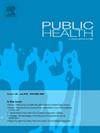Global and regional burden of breast cancer attributable to high BMI, 1990–2036: A comprehensive analysis
IF 3.9
3区 医学
Q1 PUBLIC, ENVIRONMENTAL & OCCUPATIONAL HEALTH
引用次数: 0
Abstract
Objectives
This study aimed to assess global, regional, and national trends in breast cancer burden attributable to high body mass index (BMI) from 1990 to 2021 and provide projections up to 2036 using data from the Global Burden of Disease (GBD) 2021 study.
Study design
Systematic analysis of the GBD 2021 dataset.
Methods
We extracted high BMI-related breast cancer data from the GBD 2021 dataset, covering 204 countries and territories. Age-standardized mortality rates (ASMR), disability-adjusted life years (DALYs), and estimated annual percentage changes (EAPCs) were calculated to analyze temporal patterns and regional differences. Future trends were projected using the Bayesian age-period-cohort (BAPC) model.
Results
In 2021, high BMI contributed to 44,707 breast cancer deaths and 1,041,309 DALYs globally, reflecting a 138.5 % and 142.7 % increase, respectively, compared to 1990. While global age-standardized mortality and DALY rates remained relatively stable, the absolute burden significantly increased, particularly in low- and middle-SDI regions. High-SDI regions exhibited the highest age-standardized rates, but low-SDI regions showed the fastest growth. Projections indicate that the global burden of breast cancer due to high BMI will continue to rise until 2036, driven by increasing obesity rates and insufficient healthcare resources.
Conclusions
High body mass index is a major driver of the global breast cancer burden, showing increasing trends not only in high-income regions but more prominently in low-SDI regions. Effective strategies, including public health interventions targeting obesity management, are needed to control the rising burden.
1990-2036年全球和地区高BMI乳腺癌负担的综合分析
研究设计对 GBD 2021 数据集进行系统分析方法我们从 GBD 2021 数据集中提取了与高体重指数相关的乳腺癌数据,涵盖 204 个国家和地区。我们计算了年龄标准化死亡率(ASMR)、残疾调整生命年(DALYs)和估计年度百分比变化(EAPCs),以分析时间模式和地区差异。结果2021年,高体重指数导致全球44,707例乳腺癌死亡和1,041,309个残疾调整生命年,与1990年相比,分别增长了138.5%和142.7%。虽然全球年龄标准化死亡率和残疾调整寿命年数率保持相对稳定,但绝对负担却显著增加,尤其是在中低收入地区。高 SDI 地区的年龄标准化死亡率最高,但低 SDI 地区的增长速度最快。结论高体重指数是全球乳腺癌负担的主要驱动因素,不仅在高收入地区呈上升趋势,而且在低体重指数地区更为突出。需要采取有效的策略,包括针对肥胖管理的公共卫生干预措施,来控制不断增加的负担。
本文章由计算机程序翻译,如有差异,请以英文原文为准。
求助全文
约1分钟内获得全文
求助全文
来源期刊

Public Health
医学-公共卫生、环境卫生与职业卫生
CiteScore
7.60
自引率
0.00%
发文量
280
审稿时长
37 days
期刊介绍:
Public Health is an international, multidisciplinary peer-reviewed journal. It publishes original papers, reviews and short reports on all aspects of the science, philosophy, and practice of public health.
 求助内容:
求助内容: 应助结果提醒方式:
应助结果提醒方式:


